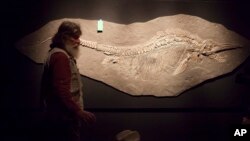Ichthyosaurs were a hugely successful group of marine reptiles that flourished in the world's oceans for more than 150 million years, with many looking much like today's dolphins and some getting even bigger than a sperm whale.
But the extensive ichthyosaur fossil record had not included any of the earliest forms representing the transition from their land reptile ancestors to creatures fully adapted to life in the sea.
Until now.
Scientists said Wednesday that they had unearthed in China the fossil of a small ichthyosaur with large, flexible flippers that let it move around on land like a seal while spending most of its time in the water 248 million years ago.
They called it the long-sought missing link revealing the early evolution of ichthyosaurs, one of the dominant marine reptile groups during the age of dinosaurs.
"We finally got this milestone and this first ichthyosaur," said paleontologist Da-yong Jiang of Peking University in Beijing, who co-led the study published in the journal Nature.
In good shape
The creature, named Cartorhynchus lenticarpus, was 16 inches (40 cm) long and had a short snout it may have used for suction feeding of creatures like worms from the seabed. The fossil, excavated in 2011 in China's Anhui province, is quite well-preserved, with only part of the tail missing.
"Cartorhynchus represents a stage of the land-to-sea transition that was somehow lacking in the fossil record of the ichthyosaur lineage, while known in most other marine reptile and mammal lineages," said University of California-Davis paleontologist Ryosuke Motani, the other study co-leader.
"The fossil that we found is the first to fill this gap in the fossil record," Motani added. "This is particularly important because some creationists tried to use ichthyosaurs as a counterexample against Darwinian evolution since the group lacked this record."
Similarly amphibious creatures have been found in the early evolutionary lineage of other groups that made land-to-sea transitions, like whales. For example, the "walking whale" Ambulocetus also spent time on land.
"Early transitional forms like Cartorhynchus give us the starting point to trace the evolution of each group," said Motani, whose team worked with China's Anhui Geological Museum.
Cartorhynchus boasted flexible wrists, needed for crawling on land. While most later ichthyosaurs possessed elongated, beaklike snouts like a dolphin, Cartorhynchus had a short snout like a land reptile.
It lived early in the Triassic period during a time perfect for evolutionary innovation: four million years after Earth's worst mass extinction erased countless sea creatures at the Permian period's end.
Top predators
Ichthyosaurs quickly emerged as the top predators of the new marine ecosystem arising after this calamity. They thrived until the group went extinct about 95 million years ago.
Many ichthyosaurs looked like dolphins, except with vertical rather than horizontal tail flukes. They ate fish and squid.
Fossils show ichthyosaurs giving live birth to their young. The biggest included Shastasaurus, measuring about 70 feet (21 meters).
The genus name Cartorhynchus means "truncated snout." The species name lenticarpus means "flexible wrist."








